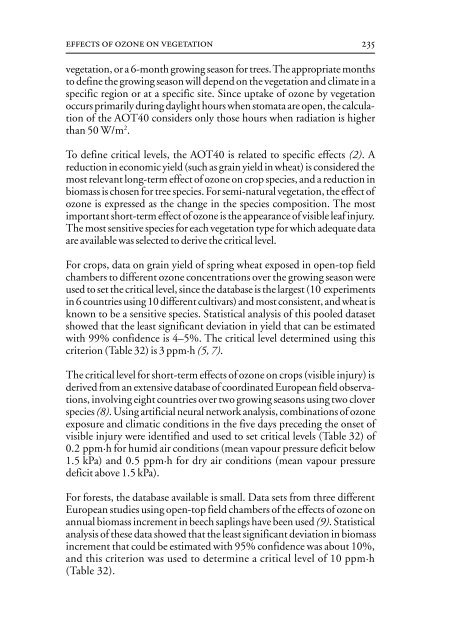Air Quality Guidelines - World Health Organization Regional Office ...
Air Quality Guidelines - World Health Organization Regional Office ...
Air Quality Guidelines - World Health Organization Regional Office ...
Create successful ePaper yourself
Turn your PDF publications into a flip-book with our unique Google optimized e-Paper software.
effects of ozone on vegetation<br />
vegetation, or a 6-month growing season for trees. The appropriate months<br />
to define the growing season will depend on the vegetation and climate in a<br />
specific region or at a specific site. Since uptake of ozone by vegetation<br />
occurs primarily during daylight hours when stomata are open, the calculation<br />
of the AOT40 considers only those hours when radiation is higher<br />
than 50 W/m 2 .<br />
To define critical levels, the AOT40 is related to specific effects (2). A<br />
reduction in economic yield (such as grain yield in wheat) is considered the<br />
most relevant long-term effect of ozone on crop species, and a reduction in<br />
biomass is chosen for tree species. For semi-natural vegetation, the effect of<br />
ozone is expressed as the change in the species composition. The most<br />
important short-term effect of ozone is the appearance of visible leaf injury.<br />
The most sensitive species for each vegetation type for which adequate data<br />
are available was selected to derive the critical level.<br />
For crops, data on grain yield of spring wheat exposed in open-top field<br />
chambers to different ozone concentrations over the growing season were<br />
used to set the critical level, since the database is the largest (10 experiments<br />
in 6 countries using 10 different cultivars) and most consistent, and wheat is<br />
known to be a sensitive species. Statistical analysis of this pooled dataset<br />
showed that the least significant deviation in yield that can be estimated<br />
with 99% confidence is 4–5%. The critical level determined using this<br />
criterion (Table 32) is 3 ppm·h (5, 7).<br />
The critical level for short-term effects of ozone on crops (visible injury) is<br />
derived from an extensive database of coordinated European field observations,<br />
involving eight countries over two growing seasons using two clover<br />
species (8). Using artificial neural network analysis, combinations of ozone<br />
exposure and climatic conditions in the five days preceding the onset of<br />
visible injury were identified and used to set critical levels (Table 32) of<br />
0.2 ppm·h for humid air conditions (mean vapour pressure deficit below<br />
1.5 kPa) and 0.5 ppm·h for dry air conditions (mean vapour pressure<br />
deficit above 1.5 kPa).<br />
For forests, the database available is small. Data sets from three different<br />
European studies using open-top field chambers of the effects of ozone on<br />
annual biomass increment in beech saplings have been used (9). Statistical<br />
analysis of these data showed that the least significant deviation in biomass<br />
increment that could be estimated with 95% confidence was about 10%,<br />
and this criterion was used to determine a critical level of 10 ppm·h<br />
(Table 32).<br />
235

















